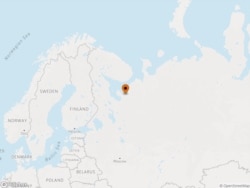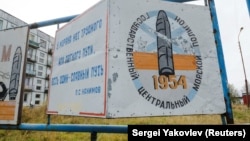U.S. intelligence and some independent experts have attributed a deadly radioactive explosion in Russia's Far North on August 8 to a failed test of a nuclear-propelled cruise missile capable of flying at hypersonic speeds.
Others, however, have expressed skepticism, saying the lack of definitive proof leaves the door open to possibilities other than the explosion of a Burevestnik missile prototype at a naval testing ground in the Arkhangelsk region.
The Sketchy Official Version
Russia's Rosatom nuclear agency issued a statement on August 10 saying that five scientists were killed in the incident while conducting "work related to the engineering and technical support of an isotope power source in a liquid-propulsion system." The incident occurred at the Nyonoksa military testing site.
Rosatom is believed to be involved in testing the Burevestnik through the Russian Federal Nuclear Center's Research Institute of Experimental Physics, which reported that thousands of residents of Sarov -- a closed nuclear-research city in the Nizhny Novgorod region where the institute is located -- on August 12 participated in a ceremony to honor the "testers who died at a military training ground."
"Most of the evidence about the Arkhangelsk event points to the Burevestnik program being the culprit," Ankit Panda, a nuclear expert at the nonprofit Federation of American Scientists, told RFE/RL in written comments. "This assessment is shared by the U.S. intelligence community."
Panda noted the Nyonoksa test site's resemblance to others where the Burevestnik is known to have been tested and the involvement of scientists affiliated with the Sarov nuclear-research institute.
"We also see signs that the Serebryanka" -- a nuclear-fuel carrier that was present during previous Burevestnik tests and could potentially be used to transport a nuclear device -- "was situated near the incident site."
War Engine
This evidence -- along with reports of heightened radiation levels recorded in the nearby city of Severodvinsk* -- has been cited by media as pointing to the top-secret, nuclear-powered cruise missile dramatically announced by President Vladimir Putin during a televised speech in March 2018.
But the case is far from closed.
Edwin Lyman, acting director of the Union of Concerned Scientists' Nuclear Safety Project, told RFE/RL on August 16 that he was "initially skeptical" that the accident involved a Burevestnik system because such an event would generate a range of different fission products, some of which are fairly dispersible and could be detected in trace amounts far away.
"It's not just the radiation level, but the type of radiation," he said, and to date nobody has reported the presence of radioactive iodine, which would indicate a reactor accident.
"We don't know if the U.S. or other countries…have detected things that they are just not reporting, but it would be pretty obvious if there were a serious accident involving a nuclear reactor of the size needed," he told RFE/RL.

Andrei Zolotkov, head of Bellona-Murmansk, the Russian chapter of the Norway-based Bellona Foundation independent environmental monitor, wrote to RFE/RL on August 15 that "there is no final conclusion, because the information is presented in doses and in an often contradictory way."
All that is clear, he said, is that the accident was related to the testing of a "nuclear device" at a military site.
Zolotkov gave two alternative scenarios: an accident involving either "a small-sized nuclear installation or a radioisotope thermoelectric generator (RTG)."
Russian and other media have reported the possibility that the accident involved the testing of an RTG, which would be in line with Rosatom's description of a "radio isotope power source." RTGs are essentially generators that produce energy by capturing heat released by radioactive decay.
The Russian pro-government daily Izvestiya on August 15 cited an unidentified military source as saying that the Nyonoksa occurred during the testing of a new accelerator -- a liquid-propellant system on which RTGs were mounted.
The purpose of such a system has not been explained, but the paper noted that the Research Institute of Experimental Physics has been involved in the development of such power sources, adding that they have applications both in weaponry and space exploration.
There are other reasons to believe the incident might not have involved a nuclear-powered cruise missile. The general assumption is that Russia's program would employ technology similar to that tested by the United States in the late 1950s and early 1960s, when it worked on its own nuclear-propelled cruise missile.
Before the idea was abandoned in 1964, Project Pluto resulted in the construction and testing of the world's first nuclear "ramjet" engine -- in which cool air is drawn in, heated to expansion by a nuclear reactor, and then exhausted to produce thrust.
Isotope engines would not be suitable for such a system, according to Lyman. And Russia's mention of a liquid-propulsion system also does match with the Project Pluto ramjet, which didn't use liquid nuclear fuel.
"So if they were accurate in their description, and of course that's a big 'if'," he said of the Russian authorities, "it didn't sound like a description of a Project Pluto-type engine."
Panda noted that Russian sources have recently suggested the Burevestnik might use "a radioisotope power source, like what many satellites use." But he added that "this doesn't seem to make sense for a cruise missile, which would require higher power."
"That sort of power likely would come from a fast reactor using highly enriched uranium, possibly with liquid metal coolant," he wrote.
The Big Question
To date, according to Panda, there have been 14 tests of the Burevestnik, and "none, as far as I know, have been fully successful with the nuclear-propulsion unit."
But that has not prevented Washington from taking note of the recent incident, which U.S. intelligence has reportedly concluded was the result of a Burevestnik test.
U.S. national-security adviser John Bolton told Voice of America on August 14 that the incident demonstrates that Russia is "still spending enough on defense to not only modernize their nuclear arsenal to build new kinds of delivery vehicles, hypersonic glide vehicles, hypersonic cruise missiles, largely stolen from American technology."
The U.S. Atomic Energy Commission declassified the Project Pluto ramjet technology in 1972, so it is unclear what theft Bolton had in mind.
"It is almost impossible to influence attempts to develop new weapons," Zolotkov wrote.
He and other experts have greater concerns about the August 8 incident.
Panda wrote that "the dangers in flying any vehicle with an onboard reactor or even radioisotope power generator is the risk of radioactive dispersal upon a crash or accident."
"In this case, the explosion caused a radiological dispersal event," he said, describing such events as "terribly damaging to humans and the environment."
Whatever was being tested, Zolotkov wrote, "the main question is whether this device was destroyed or not. And where is it currently located? Is it safe or lost?"
"In this case, plausible explanations should be given," Zolotkov wrote. "And I repeat once again -- there should not be any experiments with a 'nuclear device' so close to a big city."
Arkhangelsk has a population of about 350,000. The regional administration on August 13 announced a tender for the purchase of 1,200 gas masks capable of offering protection from "radioactive, toxic, biological, and chemical hazardous substances from man-made accidents," the Open Media news website in Russia reported.










